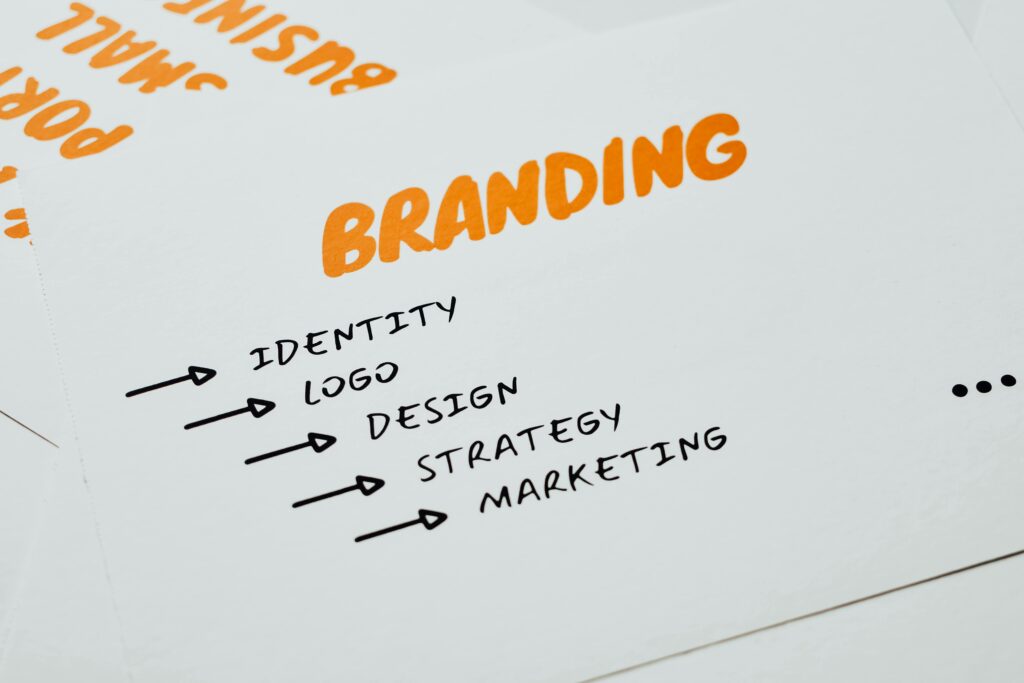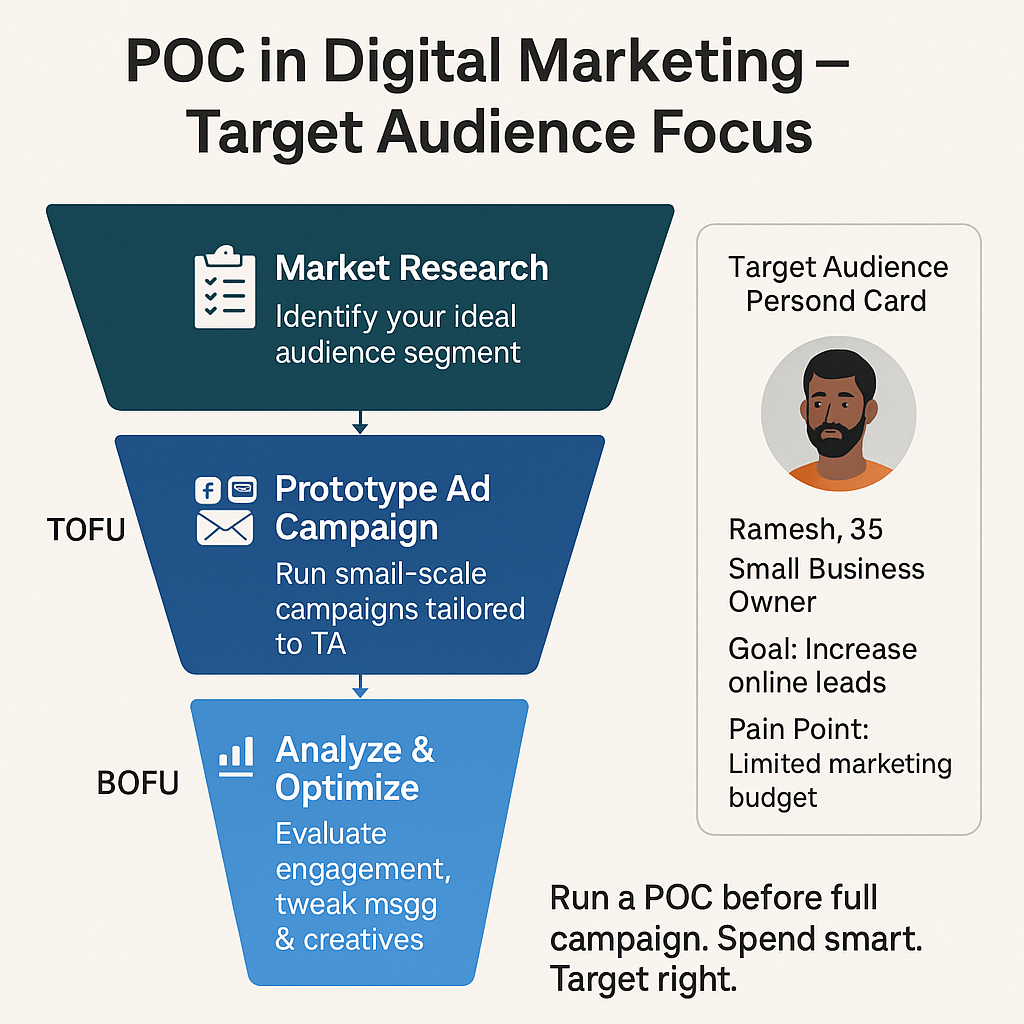POC full form is Proof of Concept.
In business and marketing, a POC is a small-scale test used to validate whether an idea, campaign, or strategy will work before making a big investment.
POC Meaning in Business, Digital Marketing, and How It Protects Your Budget
Launching a big marketing campaign is exciting.
New creative.
Big goals.
High hopes.
But here’s the harsh truth:
Most campaigns flop.
Not because the product is bad…
However, the marketing message, audience targeting, or channel choice wasn’t tested.
That’s where a POC steps in.
Let’s unpack it.
Table of Contents
POC Meaning in Business: What It Means in Digital Marketing?
POC = Proof of Concept.
In business, a POC is a small-scale validation. It answers a basic but critical question:
“Will this idea work in the real world?”
In digital marketing, a POC is a lightweight campaign—a small test with real traffic, real content, and real targeting.
The goal?
- Validate your core assumptions.
- See how the market responds.
- Optimize before scaling.
This isn’t theory.
It’s live-fire testing.
You don’t just ask customers what they think—you watch what they do.

POC vs. Pilot vs. Full-Scale Launch
Don’t confuse a POC with a pilot.
They’re related—but different.
| Concept | Scope | Purpose | Risk Level |
| POC | Small-scale test | Validate concept or approach | Very low |
| Pilot | Mid-scale | Test a full version on a segment | Medium |
| Full Launch | Large-scale | Go live with full investment | High |
POC = Quick, cheap, insightful.
Pilot = Broader rehearsal.
Launch = Final, polished rollout.
A good marketing process flows in that order.
Jumping to the end without validation is a gamble.
Why Build a POC Before Going Big?
Let’s be honest:
Marketing budgets aren’t infinite.
And attention spans are even shorter.
So if your message doesn’t land right away…
You’re burning cash.
A POC gives you:
- Real-world proof that your audience wants what you’re offering.
- Clarity on what works—and what doesn’t.
- Performance data you can trust before scaling.
Think of it as product-market fit for your campaign.
Don’t guess, Test.
The Top Benefits of a Digital Marketing POC
Running a POC isn’t just smart—it’s strategic.
Here’s what you gain:
1. Lower Risk, Higher Confidence
You get to experiment—without major consequences.
Find red flags early.
Fix flaws fast.
Make decisions with data, not gut feelings.
2. Budget Efficiency
Instead of spreading budget across unproven channels or creatives…
…you invest in what works.
Discover your highest ROI by using a POC to pinpoint the best ad platform, audience segment, or value prop.
3. Speed to Market (Without Guesswork)
You move faster because you’ve already validated the core.
No overthinking.
No endless revisions.
Just scale the proven.
4. Message Optimization
One of the most common reasons campaigns fail?
Poor messaging.
A POC lets you A/B test:
- Headlines
- CTAs
- Offers
- Visuals
…before your full campaign goes live.

A Real-World Example of a POC
Let’s say you run an online skincare brand.
You plan to launch a big Facebook Ads campaign for a new face serum.
But before spending ₹1,00,000 on ads, you decide to run a POC.
Here’s what you do:
- Spend just ₹5,000 on a test campaign
- Try two versions of ad copy: one talking about “glowing skin” and one about “acne-free skin”
- Run it for 7 days
- Track results like clicks, cost per click, and sales
After the POC, you find:
- The “acne-free” ad gets 3X more clicks
- 70% of the buyers are between agesof 18–25
- Instagram performs better than Facebook
Now, you know what to do.
You build your full campaign focusing on young women, acne concerns, and Instagram.
This POC saved you from spending ₹1L on the wrong message and wrong platform.
That’s the magic of testing small before going big.
What Happens If You Skip the POC?
Let’s paint the worst-case scenario.
You launch a ₹2L campaign.
And…
- CTR is low.
- Conversions are worse.
- Feedback is negative.
- Your boss/client is furious.
Now you’re scrambling to pivot—with no roadmap.
Skipping the POC means:
- Higher cost-per-acquisition (CPA)
- Lower return on ad spend (ROAS)
- Wasted time and team morale
- Risk to your brand’s reputation
It’s a dangerous game.
And it’s 100% avoidable.
How a POC Informs Your Marketing Strategy
A successful POC gives you a performance blueprint for scaling up.
Here’s how:
1. Targeting Precision
You’ll learn:
- Which audience segments respond best
- Which geographies convert more
- Which customer pain points resonate most
2. Channel Clarity
Should you double down on Meta Ads?
Try Google Display Network?
Explore influencer partnerships?
A POC provides clear winners (and losers).
3. Creative Direction
Want to know what kind of copy, tone, or visuals actually drive clicks?
Test. Measure. Learn.
You’ll avoid creative guesswork—and launch with clarity.
The Essential Ingredients of a POC
Want your POC to deliver strong insights?
Make sure it includes these:
1. Clear Goals
Start with a question like:
“Can we generate leads under ₹100 each from cold Facebook traffic?”
Don’t test too many things at once.
2. Defined Audience
Choose one or two buyer personas.
Don’t overcomplicate it.
Keep it targeted.
3. Key Metrics
Track performance using:
- CTR
- CPC
- Conversion rate
- CPA
- ROAS
Set benchmarks upfront
4. Budget Constraints
Keep it lean. But meaningful.
A typical POC budget: ₹5K–₹50K, depending on scope.
5. Test Duration
Minimum: 7–14 days.
Enough to gather meaningful data.
What Is a Company POC?
In simple words:
A POC in a company is a trial run to prove an idea will work in real-world conditions.
It reduces risk, saves costs, and improves outcomes before spending more time or money.

Common Areas Where Companies Use POC:
- Marketing Campaigns
Test ad creatives, messaging, or platforms before a full campaign launch. - Software Development
Build a basic version of an app or tool to check if the concept is technically possible. - Product Development
Try a sample product to get early feedback from customers. - Partnerships or Tools
Try a new CRM, automation tool, or agency service to see if it fits the company’s needs.
Key Details in a Company POC:
| Element | Description |
| Objective | What are we trying to test or prove? |
| Scope | How small or limited will the test be? |
| Timeline | How long will the POC run? (Typically 1–4 weeks) |
| Budget | How much are we willing to invest in testing? |
| Success Criteria | What metrics will show that the POC worked? (e.g., cost per lead, speed, user feedback) |
| Team Involved | Who’s running the test and analyzing results? |
Example:
Scenario:
An e-commerce company wants to try influencer marketing.
Instead of spending ₹ 2 L on 10 influencers, they run a POC with just 1 influencer for ₹ 10 K.
They track:
- Engagement
- Traffic
- Sales from the influencer link
If results are good → they scale the strategy.
If not → they rethink before spending more.
Real-World Case Studies
Case Study 1: SaaS Startup Boosts Demo Requests 3X
A B2B SaaS company ran a 10-day POC using two LinkedIn Ads.
Version A used a generic value proposition.
Version B focused on one clear pain point.
Result?
- Version B had 3X higher click-through rate.
- Cost-per-lead dropped by 60%.
They built their entire campaign strategy around that insight, and doubled their pipeline in 90 days.
Case Study 2: E-commerce Brand Skips POC, Loses ₹5L
A D2C fashion brand launched a full-scale influencer campaign with zero testing.
Result?
- Poor brand-audience fit
- Low engagement
- Less than ₹50K in return from ₹5L spend
Had they tested on a small scale, they could’ve pivoted to a better influencer vertical.
Cost, ROI & Financial Impact of a POC
Let’s talk numbers.
Here’s how a POC saves and earns:
| Metric | Without POC | With POC |
| Avg. Cost Per Lead | ₹400 | ₹150 |
| Campaign Spend | ₹1,00,000 | ₹50,000 |
| Conversion Rate | 0.8% | 3.2% |
| Marketing ROI | Negative | 4–6x |
Small test = big payoff.
The ROI isn’t just in conversions—it’s in confidence.
Best Practices for Running a Winning POC
Want your POC to succeed?
Here’s your checklist:
- Define ONE core hypothesis
- Test ONE variable at a time
- Use real targeting, platforms, and creative
- Keep budget tight but impactful
- Let the data guide you, not assumptions
- Document everything and learn from it
Bonus Tip: Run multiple POCs over time. Stack learnings.

Final Thoughts
A full-scale marketing campaign without a POC is like building a house without a blueprint.
It’s expensive.
Risky.
And avoidable.
But a well-run POC?
That’s your insurance policy.
It reduces waste
Sharpens your strategy.
And sets you up to win.

